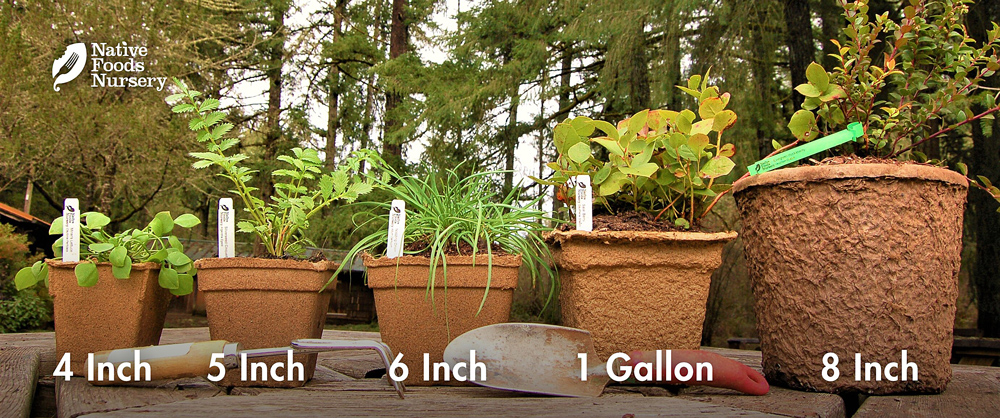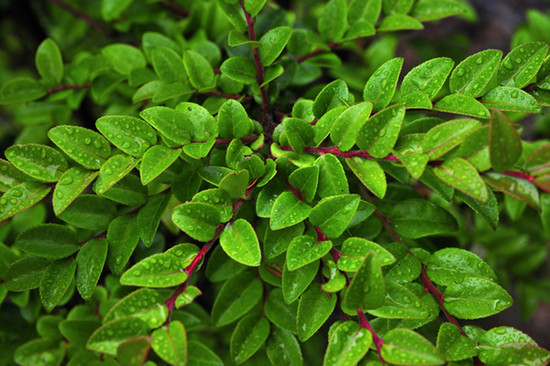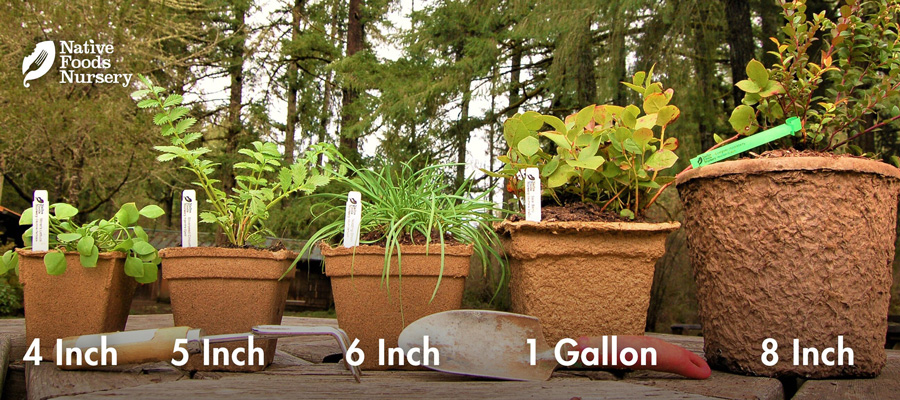Evergreen Huckleberry
- Current Stock:
- 0
- Other Names:
- Winter Huckleberry, California Huckleberry, EeEelac (Puget Sound Salish, pronounced “ee-EEL-ahk”)
- Latin Name:
- Vaccinium Ovatum
Evergreen Huckleberry (Vaccinium ovatum) is a jewel of the coastal Northwest, offering glossy green foliage, pink-tinged spring flowers, and late-season black berries. It’s arguably the easiest and most adaptable huckleberry for gardeners and—unlike most others—keeps its foliage year-round, making it both ornamental and edible [1][4][8]. It’s no wonder it’s one of our most popular plants!
Edible Uses
The small, but prolific, black berries are enjoyed fresh, cooked, or dried and make excellent jams, jellies, and preserves [5][9]. Sweeter even than Black Huckleberry[11], they also contain anthocyanins and other polyphenols with notable antioxidant capacity, along with supportive vitamins [10].
Ornamental Qualities
Compact and adaptable, Evergreen Huckleberry works as a hedge, container plant, or woodland understory shrub. Glossy leaves, pink spring flowers, and black fruit provide four-season interest [4][7]. Pairs well with Salal and Lingonberry for a low-growing, evergreen edible border.
Environment and Culture
Native from coastal British Columbia to central California, often flourishing on acidic soils along forest edges and coastal scrub [1][2][3]. It provides late nectar for pollinators and abundant fruit for birds and wildlife [6][8]. Indigenous communities continue to harvest and tend Evergreen Huckleberry as a valued food and cultural plant. Acknowledging Indigenous stewardship affirms living traditions and ecological knowledge that sustain both the plant and the places it grows [5][9]. (Learn more & how to help on our Charitable Giving page.)
Harvest, Care, and Preparation
Plant in acidic, well-drained soil; tolerant of shade and salt spray. Water regularly during establishment, then reduce. For best crops, aim for 6+ hours of sun (give afternoon shade in hot inland sites); deep shade reduces fruiting [4][7]. In many sites, flavor peaks after the first light frost—harvest when berries are deep black and fully flavored, before a hard freeze [7].
(See planting guide in next tab for more details)
Attributes
Native Range: BC → WA/OR → central CA (coastal forests, edges, scrub)
USDA Zones: 7–9 (some sites 6 with protection/microclimate)
Ease of Care: Easy–Moderate
Deer Resistance: Moderate
Light Requirements: Full sun to full shade (best fruit with 6+ hours; give afternoon shade in hot inland sites)
Soil Type: Strongly acidic, well-drained, organic-rich; avoid alkaline soils
Water Requirements: Summer-dry tolerant once established; best fruit with steady summer moisture
Pollination: Self-fertile; bee activity improves set
Bearing Age: ~2–4 years from planting
Size at Maturity: ~4–8 ft (larger in mild coastal sites; can be kept 3–5 ft with pruning)
Plant Spacing: 3–5 ft (2–3 ft for a tight hedge)
Bloom Time: April–June
Harvest Time: August–October (often later on the coast)
References
[1] USDA PLANTS Database — species profile.
[2] Flora of North America — taxon treatment.
[3] Jepson eFlora — California distribution & habitat notes.
[4] Oregon State University Landscape Plants — horticultural notes.
[5] Moerman, Native American Ethnobotany — Indigenous food use.
[6] USFS Plant Guides — wildlife value & ecological roles.
[7] Native Plant Network & Extension publications — cultivation guidance.
[8] Pojar & MacKinnon, Plants of the Pacific Northwest Coast — ecology & natural history.
[9] Turner, Food Plants of Coastal First Peoples — cultural tending & food use.
[10] Peer-reviewed nutrition/phytochemistry — anthocyanins, polyphenols, vitamins; antioxidant capacity.
[11] Lee, J., Finn, C.E., & Wrolstad, R.E. (2004). Comparison of anthocyanin pigment and other phenolic compounds of Vaccinium membranaceum and Vaccinium ovatum native to the Pacific Northwest of North America. Journal of Agricultural and Food Chemistry 52(23): 7039–7044.
Pot Sizing Guide

Planting Guide: Evergreen Huckleberry (Vaccinium ovatum)
Tip: Think “coastal forest edge.” Use acidic, organic-rich soil and a conifer-duff mulch; in hot inland sites give afternoon shade and steady summer water for best crops.
Choosing a Site
Light: Full sun to full shade; best fruiting with 6+ hours. In hot inland areas, provide afternoon shade.
Soil: Strongly acidic (approx. pH 4.5–6), well-drained, organic-rich. Blend in fine bark/needles, rotted wood, or peat/coir; avoid alkaline amendments.
Space: 3–5 ft between plants (2–3 ft for a tight hedge). Can be kept 3–5 ft tall with light pruning.
Planting Steps
Plant in fall or spring (spring in cold-winter regions; fall in hot-summer regions).
Dig a wide hole and amend the backfill with composted bark/leaf mold for acidity and moisture retention.
Set the plant at the same depth as the container; loosen circling roots gently. Backfill and water deeply to settle.
Mulch 2–3 in. with pine needles or conifer wood chips (keep mulch a few inches off stems).
In hot sites, provide temporary shade cloth or nurse plants during the first summer.
Watering & Care
Establishment: Keep evenly moist (not waterlogged) for the first 1–2 years.
After establishment: Summer-dry tolerant, but best fruit with steady summer moisture.
Pruning: Minimal. After fruiting, thin a few oldest stems to renew growth; light shaping in late winter.
Feeding: Light spring compost or an acid-forming organic fertilizer only if growth is weak; avoid heavy nitrogen.
Pollination: Self-fertile; native bees improve fruit set.
Heat & airflow: Maintain mulch to keep roots cool; provide good airflow and shelter from hot, dry winds.
Protection
Wildlife: Birds relish the fruit—use lightweight netting as berries color if you need more for the kitchen.
Cold & deer: Hardy in USDA 7–9 (occasionally 6 in mild microclimates). Protect young plants from deer browse.
Soil/rot: Avoid poorly drained sites; ensure drainage to prevent root issues.
Companions: Salal, Red Huckleberry, Serviceberry, Oso Berry, Lingonberry, native ferns/heathers—building a cool, multi-season understory.
Harvest Basics
Timeline: First light crops typically 2–4 years after planting.
Season: Late summer into fall (often August–October); flavor may peak after a first light frost—harvest before a hard freeze.
Use: Excellent fresh; outstanding in jams, jellies, muffins, crisps; dries and freezes well for off-season use.












